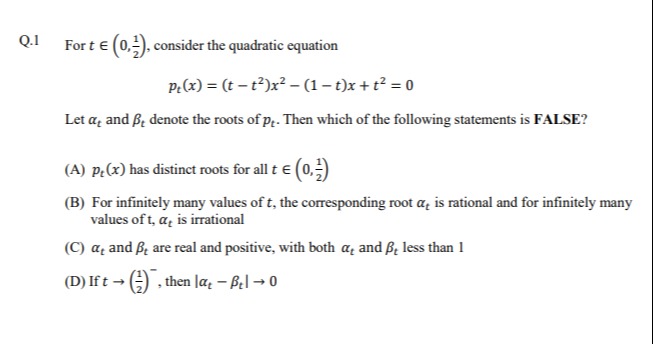Question
Question: For $t \in (0, \frac{1}{2})$, consider the quadratic equation $$p_t(x) = (t-t^2)x^2 - (1-t)x + t^2 ...
For t∈(0,21), consider the quadratic equation
pt(x)=(t−t2)x2−(1−t)x+t2=0
Let αt and βt denote the roots of pt. Then which of the following statements is FALSE?

pt(x) has distinct roots for all t∈(0,21)
For infinitely many values of t, the corresponding root αt is rational and for infinitely many values of t, αt is irrational
αt and βt are real and positive, with both αt and βt less than 1
If t→(21)−, then ∣αt−βt∣→0
αt and βt are real and positive, with both αt and βt less than 1
Solution
The given quadratic equation is pt(x)=(t−t2)x2−(1−t)x+t2=0 for t∈(0,21).
The coefficients are a=t(1−t), b=−(1−t), c=t2.
For t∈(0,21), t>0 and 1−t>21>0, so a=t(1−t)>0.
Statement (A): pt(x) has distinct roots for all t∈(0,21).
The discriminant is D=b2−4ac=(−(1−t))2−4(t(1−t))(t2)=(1−t)2−4t3(1−t).
Since t∈(0,21), 1−t=0. We can factor out (1−t):
D=(1−t)(1−t−4t3).
For t∈(0,21), 1−t>21>0.
Let f(t)=1−t−4t3. f′(t)=−1−12t2. For t∈(0,21), f′(t)<0, so f(t) is strictly decreasing.
f(0)=1, f(21)=1−21−4(81)=1−21−21=0.
Since f(t) is strictly decreasing on (0,21) and f(21)=0, we have f(t)>0 for all t∈(0,21).
Thus, D=(1−t)f(t)>0 for all t∈(0,21). The roots are distinct and real.
Statement (A) is TRUE.
Statement (C): αt and βt are real and positive, with both αt and βt less than 1.
From (A), the roots are real.
The sum of roots is αt+βt=a−b=t(1−t)1−t=t1.
The product of roots is αtβt=ac=t(1−t)t2=1−tt.
For t∈(0,21), t>0 and 1−t>0.
Sum of roots t1. Since t∈(0,21), t1∈(2,∞). So αt+βt>2.
Product of roots 1−tt. Since t∈(0,21), 1−t∈(21,1).
As t increases from 0 to 21, 1−tt increases.
At t→0+, 1−tt→0.
At t→(21)−, 1−tt→1/21/2=1.
So αtβt∈(0,1).
Since the sum and product of roots are positive, both roots must be positive.
We need to check if both roots are less than 1.
Consider the value of pt(1)=(t−t2)(1)2−(1−t)(1)+t2=t−t2−1+t+t2=2t−1.
For t∈(0,21), 2t∈(0,1), so 2t−1∈(−1,0).
Thus pt(1)=2t−1<0 for all t∈(0,21).
Since the leading coefficient a=t(1−t)>0 and pt(1)<0, the roots αt and βt must lie on opposite sides of 1.
Let αt<βt. Then αt<1 and βt>1.
This contradicts the statement that both αt and βt are less than 1.
Statement (C) is FALSE.
Statement (D): If t→(21)−, then ∣αt−βt∣→0
The difference of roots is given by:
∣αt−βt∣=∣a∣D=t(1−t)(1−t)(1−t−4t3)=t1−t1−t−4t3.
As t→(21)−, we have:
1−t−4t3→1−21−4(81)=0
1−t→21
Thus, ∣αt−βt∣→21210=0.
Statement (D) is TRUE.
Since (A) and (D) are TRUE, and (C) is FALSE, the answer is (C).
